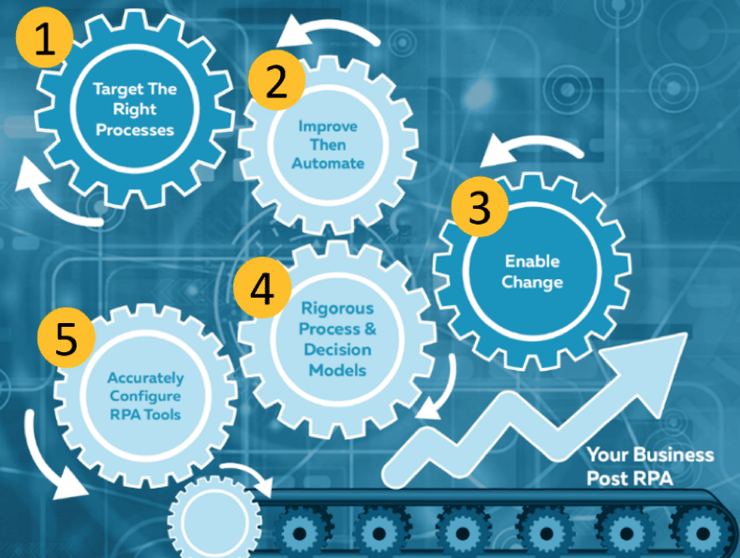










































 Intelligent robots and processes are starting to take over our offices, replacing more and more human office workers.
Intelligent robots and processes are starting to take over our offices, replacing more and more human office workers.In the new BTOES Research Report about the state of Operational Excellence [1] it becomes clear: Intelligent robots and processes are starting to take over our offices and replace more and more human office workers. The number one technology solution organizations plan to invest in is Robotic Process Automation (RPA) and Artificial Intelligence (AI). But what does that mean? Do robots really take over the control of our operations?
RPA tools are software programs that operate on the user interface of other computer systems in the way a human would do [2]. They basically recognize and read fields on a screen of an application software, modify the content if necessary enter it into other fields of the same or different software. All of that happens based on predefined rules [3]. The integration of artificial intelligence (AI) and Cognitive Automation components into the RPA tools makes them even more powerful since RPA starts handling unplanned situations and deal with unstructured data. Also the handling of verbal information is possible using “Chatbots” in an RPA environment [4].
Read more: Robotic Process Automation – Pragmatic Solution or Dangerous Illusion?
The use of RPA basically transfers the application of robots from the industrial manufacturing environment to the office and service area. Just like industry robots automate routine manufacturing and assembly steps RPA robots automate the human work with data and information. Robots have not “taken over” manufacturing – although they have been present there for a long time. They provide efficiency and often quality impacts, if used the right way. But, they also need to be used in the right context and have to be “trained” and maintained appropriately. They don’t just work on their own. They require appropriate human help.
RPA has already shown significant impact, mainly by increasing efficiency through the reduction of workforce or better the replacement of human workforce through “digital workforce”. At a UK bank, RPA has replaced 80% of employees controlling account transactions so that those people could focus on higher qualified work [4]. Another bank could reduce account opening times from 20 days to 10 minutes [5] – with the same workforce. There exist many success cases like those. In most of them some degree of AI is required. Already to “understand” simple e-mails, hence unstructured data, you need an “iRPA” solution, even more if the system has to handle human language. The success cases of those intelligent robots justify the investment plans of many companies in this field.
Learn more about Robotic Process Automation.
However, the use of RPA creates also risks, like basically every automation technology does. While RPA helps to do routine work faster and at a higher quality it also can make mistakes faster and with certainty. There is no human check before executing an action. Poor data quality or the insufficient definition of business rules can lead, for example, to the ordering of the wrong parts – fast and in big quantities. Or missed claim types can lead to significant rework in the claims handling, overcompensating the automation benefits. RPA requires detailed knowledge about the business process it is used in – otherwise expected performance improvements will not be realized.
The use of RPA may also just cover symptoms without correcting the real reasons for issues. RPA may, for example be used for the automated reconciliation of account differences. However, in the mid and long-term it would be much more beneficial to correct the issues leading to those differences. Hence, RPA may hinder real progress. These potential risks can reduce RPA’s benefits significantly. However, those risks can be minimized by addressing RPA the right way.
Read More: Successful Innovation through Business Process Management
In general, it is important to evaluate RPA in the context of your organization, its goals, challenges and process management capabilities. The use of a digital technology is never about the technology itself, but about the relevant business impact. To have a clear idea about those goals and how they relate to your business processes and the potential value of RPA is a simple but important precondition for the successful use of RPA. You can segment your processes to identify where you get best value by improving their maturity level through RPA [6]. Then you create the basis for later value through a well thought through implementation. Figure 1 shows critical success factors for the implementation of RPA - enabling a fast set-up at minimal risk [5].

Figure 1: Critical success factors for the implementation of RPA [5]
A simple process management discipline supports the value-driven implementation and ongoing agile use of RPA [7][8]. It needs to become part of a pragmatic “process of process management” that transfers strategy into execution, fast and at low risk. That means a basic process governance is required as well as a systematic implementation and value realization approach, in addition to the capabilities discussed before.
Intelligent robots have started their work in our offices. However, they don’t take the office over but help to minimize routine work for the human workforce who can concentrate on more challenging tasks requiring a higher qualification. The implementation of RPA and the following ongoing process improvement requires new skills combined with modern business process management capabilities. At the end, intelligent humans make intelligent robots work – to deliver best results for an organization.
Interested in reading more about the challenges facing OpEx professionals?
References
[1] BTOES (ed.): The Global State of Operational Excellence – Critical Challenges and Future Trends. Research Report, November 2017.View our schedule of industry leading free to attend virtual conferences. Each a premier gathering of industry thought leaders and experts sharing key solutions to current challenges.
View Schedule of Events-------------------------------------------------------
Search for anything
Insights from the most progressive thought leaders delivered to your inbox.
Insights from the world's foremost thought leaders delivered to your inbox.
Being a hero is all about creating value for others. Please invite up to 5 people in your network to attend this premier virtual conference, and they will receive an invitation to attend.
If it’s easier for you, please enter your email address below, and click the button, and we will send you the invitation email that you can forward to relevant people in your network.
View our schedule of industry leading free to attend virtual conferences. Each a premier gathering of industry thought leaders and experts sharing key solutions to current challenges.
View Schedule of EventsWatch On-Demand Recording - Access all sessions from progressive thought leaders free of charge from our industry leading virtual conferences.
Watch On-Demand Recordings For FreeDelivered by the industry's most progressive thought leaders from the world's top brands. Start learning today!
View All Courses NowThe premier Business Transformation & Operational Excellence Conference. Watch sessions on-demand for free. Use code: BFH1120
Watch On-DemandInsights from the most progressive thought leaders delivered to your inbox.
Insights from the world's foremost thought leaders delivered to your inbox.
Being a hero is all about creating value for others. Please invite up to 5 people in your network to also access our newsletter. They will receive an invitation and an option to subscribe.
If it’s easier for you, please enter your email address below, and click the button, and we will send you the invitation email that you can forward to relevant people in your network.
Courtesy of Nintex Pty's Paul Hsu, below is a transcript of his speaking session on 'Improve employee productivity during and post-COVID by ...
Read this article about HP, Best Achievement in Operational Excellence to deliver Digital Transformation, selected by the independent judging panel, ...
Read this article about BMO Financial Group, one of our finalists, in the category Best Achievement in Operational Excellence to deliver Digital ...
Read this article about Cisco, one of our finalists, in the category Best Achievement of Operational Excellence in Internet, Education, Media & ...









































































































































































































